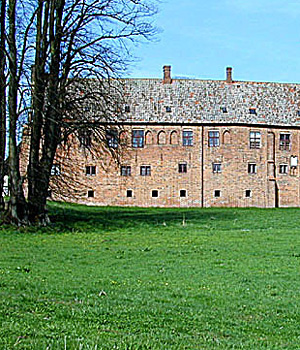| Esrum Kloster

| | Esrum kloster bliver i løbet af middelalderen den største jordbesidder i Nordsjælland.
Den tidlige middelalders stordrift på såkaldte grangier med lægbrødres arbejdskraft afløses af et system med brydegårde med tilknyttet arbejdskraft i skikkelse af gårdsæder (husmænd) og landboer (fæstebønder). |
Esrum Kloster i Nordsjælland blev etableret som cistercienserkloster i 1151 og knyttes til hovedklosteret Clairveaux i Frankrig, opkaldt efter reformatoren Bernard af Clairveaux. Endnu i dag aner man klosterets ideelle beliggenhed, isoleret på en flad strækning tæt ved Esrum Sø og op til åen, der kunne forsyne klosteret med drikkevand og vandkraft. Esrum Kloster blev fra starten begunstiget med gaver i form af jord og ejendom og udviklede sig i løbet af 1200-tallet til den største jordejer i Nordsjælland.

Esrum Kloster | 
Vandvejen | 
Esrums beliggenhed | 
Bernhard af Clairvaux |
Bryde- og fæstegårde
I en første periode frem til midten af 1200-tallet blev vægten lagt på produktion på store avlsgårde, såkaldte grangier, der blev drevet af munkene og klosterets lægbrødre. Disse fungerede primært som klostrets håndsarbejdere og deltog kun i begrænset omfang i klosterlivet. Lægbrødre- ordningen har formodentlig også været et værn mod fattigdom i tider med rigelig arbejdskraft.
Cistercienserordenen skulle ikke betale tiende og den jord som munkene arvede og selv dyrkede var i det hele taget fritaget for skat, så grangiesystemet har været givtigt og fordelagtigt. Fra omkring midten af 1200-tallet bliver det svært at hverve lægbrødre og man begyndte at afvikle grangierne til fordel for brydegårde, gårde med bestyrere og tilknyttede gårdsæder(husmænd). Omkring dette tidspunkt ophæves endvidere en intern regel om at ordenes jord ikke må bortfæstes og herefter følger også oprettelse af fæstegårde med landboere(fæstebønder).
Dyrkningsstrukturen
Dyrkningsstrukturen med brydegårde og 3-vangsbruget eksisterede i hvert fald i den vestlige del af Nordsjælland, Holbo Herred, hvor den bedste jord befandt sig. I øvrigt må man i Nordsjælland forestille sig en meget varieret produktion med udgangspunkt i en slags skovlandbrug, hvor, som tidligere nævnt, adskillelsen imellem agerland og skov var flydende og høslæt og græsning for dyrene har spillet en hovedrolle.
Produktion og kost
Naturalielandgildens sammensætning og klosterbesiddelsernes beliggenhed i Nordsjælland viser en tendens til at den vegetabilske produktion dominerer i de nordlige og vestlige dele, mens den animalske produktion dominerer omkring Nødebo i bunden af Esrum Sø, hvor der har været engdrag til græsning omkring søen. På Nordkysten omkring Hornbæk spillede fiskeproduktionen en vis rolle.
Det er imidlertid vanskeligt at sige noget præcist om levevilkår og ernæring, men en enkelt kilde, den såkaldte "Skånske ledingsret", oplyser indirekte om kostens sammensætning.

Esrums produktion |
Klosterets besiddelser
Esrumklosters besiddelser strakte sig helt ud til Øresundskysten, hvor udnyttelse af vandkraft til møller fandt sted omkring det nuværende Egebæksvang.
Klosterets besiddelser begrænsede sig imidlertid ikke kun til Sjælland. Foruden de ialt 311 fæstegårde man besad, ejede klosteret en hovedgård og 45 fæstegårde i Halland. og et ukendt antal gårde i Skåne. Endvidere besad klosteret en mølle i Helsingborg og samme sted 2 boder, som man havde fået testamenteret som gave.
I Halland havde man interesser i tømmer, bl.a. egetræ, der allerede i 1100-tallet var ved at blive en mangelvare på Sjælland. |